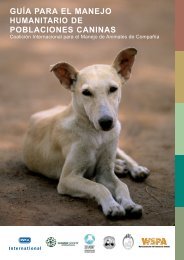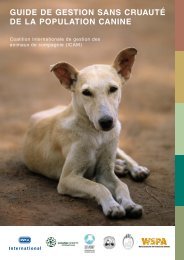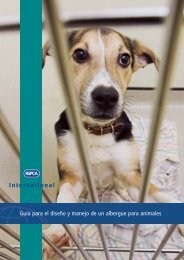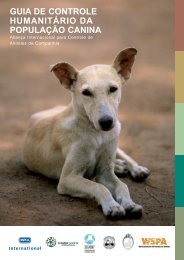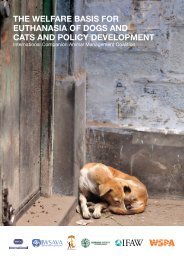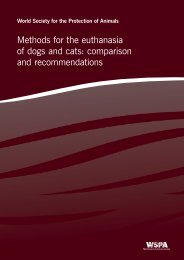HUMANE DOG POPULATION MANAGEMENT GUIDANCE - ICAM ...
HUMANE DOG POPULATION MANAGEMENT GUIDANCE - ICAM ...
HUMANE DOG POPULATION MANAGEMENT GUIDANCE - ICAM ...
Create successful ePaper yourself
Turn your PDF publications into a flip-book with our unique Google optimized e-Paper software.
Content structure<br />
This document follows the structure explained in Figure 2: A process overview, below.<br />
Figure 2: A process overview<br />
A. Initial data collection and assessment (page 07)<br />
What is the current size of the dog population and<br />
subpopulations within it?<br />
Where are the dogs coming from and why does<br />
this source exist?<br />
What welfare problems do the dogs face?<br />
What are the problems caused by the dogs (real<br />
or perceived) and what is currently being done to<br />
control these problems? Who is responsible for<br />
this control?<br />
What is currently being done to control the size of<br />
the population and why? Who is responsible?<br />
Who are the relevant stakeholders?<br />
E. Evaluate (page 19) A periodic process to re-assess the situation and strategy<br />
B.Influential factors in dog population management (pages 08–11)<br />
Consider and prioritise factors affecting<br />
population size:<br />
Human attitudes and behaviour<br />
Dog reproductive capacity<br />
Access to resources<br />
Education<br />
Legislation<br />
Registration and identification<br />
Sterilisation and contraception<br />
Planning for sustainability<br />
Aims, objectives and activities<br />
Setting standards for animal welfare<br />
Factors motivating animal control:<br />
Zoonotic disease<br />
Current roaming dog population<br />
C. Components of a comprehensive dog population management programme (pages 12–16 )<br />
D.Designing the intervention (pages 17–18)<br />
Holding facilities and rehoming centres<br />
Euthanasia<br />
Vaccination and treatment<br />
Controlling access to resources<br />
Identifying indicators that can be used to monitor<br />
and evaluate each stage of the programme<br />
E. Monitoring (page 19)<br />
A continuous process resulting in re-adjustment<br />
of implementation<br />
E. Implementation (page 19)<br />
Carry out activities<br />
Maintain minimum standards throughout<br />
06



